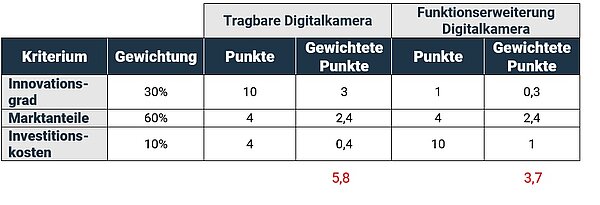House of PM GmbH
Ferdinandstraße 12
20095 Hamburg



>> Expert tip
Success is the sum of the right projects
"Should I be investing in portable digital cameras in the future or should I be optimizing my product line for analog film?" That or something like that might have been a question in a 1975 management meeting at Eastman Kodak. The wrong decision made at the time against the digital version of the classic camera, which cost Kodak its market leadership, was often cited. How good a decision was, usually only becomes apparent in retrospect. But there are methods with which such decisions can be well prepared and secured.
Evaluation with the utility / benefit analysis
The core of the project selection process is the evaluation procedure for the projects in the project portfolio. All relevant strategic parameters should be included here in as objectively measurable a way as possible. If, on the other hand, the desire for a lean, pragmatic process is kept in mind, complex calculation models are out of the question. What remains?
In medium-sized companies, the simple utility / benefit analysis is therefore often used. With the utility / benefit analysis you compare different options in a structured way using quantitative and qualitative criteria. A scale of points is defined in advance for each criterion. In this way even non-measurable criteria can be mapped into a number. As a result, you receive a weighted sum for each of the options, which represents the so-called utility value (benefit) and can then be easily ranked with the other utility values (benefits) achieved.
Procedure
Advantages
Disadvantages
Example
The management team decides to evaluate the new projects on the basis of the criteria "degree of innovation", "expansion of market shares" and "project costs". The expansion of market shares is the most important criterion (60%), the degree of innovation the second most important criterion (30%) and investment costs the least important (10%). They agree on the following scale:

Based on this scale, they evaluate the ideas at hand. Everyone quickly agrees on the degree of innovation and investment costs. In terms of market share, they fear that the introduction of a digital camera will mean a loss of market share in the existing business. However, they come to the consensus that this can be compensated by the new market share for the new product. They also do not expect any further market shares for the functional expansion, but only the continuation of the status quo.

We do not know whether the decision at Eastman Kodak in 1975 would have turned out this way with the help of the utility / benefit analysis but at least the decision would still be transparently understood today on the basis of this analysis.
Why not try it out for yourself when planning your next summer holiday. Tip: Use at least 3 and at most 10 criteria!
How to find a suitable scoring model
The quality of a scoring model depends on two aspects: the definition of suitable and clearly formulated criteria and the determination of the weighting of the criteria. Care must be taken to ensure that the most important criteria are clearly formulated and taken into account in the utility / benefit analysis. If a well-formulated strategy exists, the most important elements defined in it can be used as criteria. If there is no such specification, the most important aspects from the areas of market, costs, processes and employees can also be used.
The weighting of the selection criteria in relation to each other is the main adjustment screw of the scoring model. A subsequent calibration of the weighting has proven to be an effective procedure for a plausibility check of the scoring model. For example, an earlier good priority decision can be used and compared with the scoring result. If there are significant deviations here, the scoring model should be adjusted accordingly once again.
And then just take the test run. Take your current top 20 projects and do an assessment. Does the result reflect your current priorities or does it make you think about the investments and benefits?
House of PM GmbH
Ferdinandstraße 12
20095 Hamburg